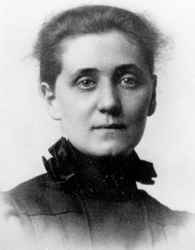Jane Addams was a pioneer in the field of social work and co-founder of the Hull House, a settlement house for lower class immigrants in Chicago. A noted pacifist and internationalist, Addams fearlessly took unpopular stances and became the first American woman ever to receive the Nobel Peace Prize.
Jane Addams’ Early Days
Laura Jane Addams was born on September 6, 1860, in Cedarville, Illinois, the eighth of nine children. Her mother, Sarah Weber Addams, died when she was 2, leaving her in the care of her father, John Addams.
A wealthy businessman, member of the Illinois state Senate and leading member of the Republican Party, John was a close friend of Abraham Lincoln. In her autobiography, Jane Addams credits her father with fostering her emotional development and intellectual curiosity, instilling in her the virtues of tolerance, philanthropy and a strong work ethic.
Jane was the valedictorian of her Rockford Female Seminary high school class, and obtained a bachelor’s degree a year later when the school became accredited as Rockford College for Women. Addams then spent six years studying medicine at Women’s Medical College in Philadelphia.
Sources in this Story
- University of Illinois at Chicago: Urban Experience in Chicago: Timeline
- The New York Times: Becoming Jane Addams
- University of Illinois at Chicago: Jane Addams Hull House Museum: About Hull-House
- Stanford Encyclopedia of Philosophy: Jane Addams
- Harvard University Library: Women Working: Jane Addams
- Chicago Tribune: Why You Should Care About Jane Addams
- The Nobel Foundation: Jane Addams Biography
Adams’ Notable Accomplishments
Though Addams’ life was fraught with calamity, she had the inherent ability to transform the “bad” into something “good.” A pivotal experience in her life was the heartache she felt as she watched her brother suffer from a mental illness, giving her the wherewithal to start a new movement.
On September 18, 1889, Addams and a friend, Ellen Starr, opened doors to the Hull House with the intent to relieve the alienation many experienced from living in poverty. Located in a Chicago immigrant pub, the house served as gymnasium, nursery, boarding house and community center.
Addams was influenced by the writings of Leo Tolstoy, and sought him out during a trip to Europe. Tolstoy was critical of her material wealth, arguing that it prevented her from being of service to those she was helping.
He chastised her by saying: “So you are an absentee landlord? Do you think you will help the people more by adding yourself to the crowded city than you would by tilling your own soil?” Addams was apparently “humbled” by this remark, according to women’s studies professor Maurice Hamington, and returned to the settlement and began working more directly with the people.
Addams also took up causes such as the child labor laws, set up the first juvenile court and created housing policies to benefit the poor. She was the first woman president of the National Conference of Charities and Corrections, vice-president of the Campfire Girls association, was involved in the NAACP, was a supporter of women’s suffrage and helped to found the American Civil Liberties Union.
During World War I, Addams remained a pacifist, which took a toll on her reputation. In the midst of the “red scare,” J. Edgar Hoover purportedly called her “the most dangerous woman in America,” and some referred to her as a “communist.”
In 1931 Addams became the first American woman to be awarded the Nobel Peace Prize.
The Rest of the Story
Addams expressed her love for literature by writing numerous books and articles, her most celebrated work being “Twenty Years at Hull House.” Until her death in 1935, she continued to work for better education and living conditions for the poor, immigrants and women.
Jane Addams’ capacity to deeply empathize with others left a lasting legacy. To perpetuate Addams’ ethos, the original Hull House settlement home is a national historic landmark, now a part of the campus at University of Illinois at Chicago. Its late 19th-century interior was restored for visitors and is known as the “Jane Addams Hull House Museum.”











